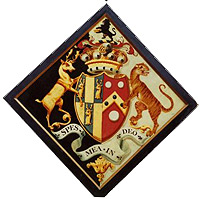|
 An
heir presumptive can never become an heir apparent, nor can he
ever carry the courtesy title. The courtesy title, if there is
one, is for the heir in the direct line. Even if the peer is ninety
years old, childless, and unmarried the heir presumptive does
not have the courtesy title. An
heir presumptive can never become an heir apparent, nor can he
ever carry the courtesy title. The courtesy title, if there is
one, is for the heir in the direct line. Even if the peer is ninety
years old, childless, and unmarried the heir presumptive does
not have the courtesy title.
The holder of an English or UK peerage cannot name his successor
nor does he have any choice in who will succeed him.
The descent of most hereditary English peerages is determined
by the patent by which the peerage was created. Except in very
rare cases, the patents say that the peerage should descend to
heirs male of the body of the one for whom it was created.
That means that ordinarily the peerage becomes extinct if the
first earl, for instance, doesn’t have a son. Once in a while
patent will let a brother or a nephew inherit if the man does
not have a son. When Admiral Lord Nelson died without a son, his
patent allowed his brother to inherit. On the other hand, and
much more typical ,was what happened to Admiral Lord Collingswood’s
peerage. It became extinct on his death because he had only daughters.
 Even
though the successor inherits the peerage as soon as the peer
dies, tradition says that he is not called by the new title until
after the funeral. Even
though the successor inherits the peerage as soon as the peer
dies, tradition says that he is not called by the new title until
after the funeral.
If there is no heir apparent, the heir presumptive has to make
certain that the widow is not pregnant before claiming the title.
Generally there is no question as to who will succeed to a peerage.
After the funeral and the will are taken care of by the executor,
the new peer petitions the Lord Chancellor for a writ of summons
to the House of Lords for the current or the next session of parliament.
The claimant has to prove that his parents were legally married
and that a son and heir was born after that marriage. Then he
has to prove he is that son and heir, over twenty-one, and a member
of the Church of England. This is generally not difficult as there
are usually many people among the aristocrats who know him.
 If
there is no son, the heir presumptive succeeds. He also petitions
the Lord Chancellor for a writ of summons. He has to prove how
he is related to the deceased, and that he and his father and
all others between him and the deceased were legitimate and were
dead. If
there is no son, the heir presumptive succeeds. He also petitions
the Lord Chancellor for a writ of summons. He has to prove how
he is related to the deceased, and that he and his father and
all others between him and the deceased were legitimate and were
dead.
Once the proofs are accepted the new peer is sent a writ of summons.
A very few peerages were created by a writ of summons to the
House of peers rather than by a patent. These peerages all date
from the earliest years of parliament and were created when the
men of that day were summoned to parliament as peers.
Unlike the peerages created by patent, a peerage created by a
writ of summons can be inherited by a daughter if there is no
son. If there is an oldest son, he alone inherits the peerage
but if there is no son, only daughters, they all inherit equally.
As it is impossible to divide a peerage into parts, none of the
women bear the title and the peerage goes into abeyance until
there is only one good claimant to the peerage. That one person
petitions the crown to have the peerage taken out of abeyance
in his or her favor.
If a female inherits a barony in her own right, she is as much
a peer as a male. However, she cannot frank letters or attend
parliament.
A Catholic peer is also as noble as a Protestant, except that
he can’t sit in parliament or frank letters, either.
 Peer
Law Peer
Law
 Succession
when a Peer Dies Succession
when a Peer Dies
 Contested
Peerages Contested
Peerages
 Number
of Peers Number
of Peers
 Introduction
of a New Peer - Fees for Promotion Introduction
of a New Peer - Fees for Promotion
 Introduction
of a New Peer to the House of Lords Introduction
of a New Peer to the House of Lords
 Table
of Precendency Among Men Table
of Precendency Among Men
 Parliamentary
Robes Parliamentary
Robes
 Female Peerage Female Peerage
|


